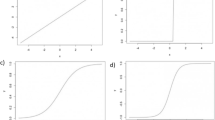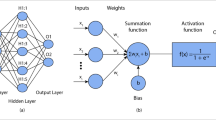Abstract
Freeform machining is one of the trickier machining operations characterized by prolonged processing durations, which lead to high energy consumption. Addressing this issue is imperative for enhancing industrial efficacy and minimizing energy consumption. This article presents modeling, simulation, optimizing, and an algorithm for reducing the long machining time of freeform geometric shapes using the Taguchi optimization technique and an artificial neural network (ANN). Firstly, the models (i.e., stock and impeller) were designed in Solidworks and imported into simulation software (SolidCAM) for machining simulation. The Taguchi L9 (3^3) was used to arrange the data using spindle speed, feed rate, and cutter diameter as the cutting conditions, and the simulation was conducted using the corresponding settings, and the machining times were recoded. Then the optimized settings were obtained, and other statistical analyses were conducted and discussed. Also, the data generated through the application of the Taguchi method was utilized to develop an advanced ANN algorithm. In addition, a second-order regression model was constructed using the Bayesian approach. This algorithm achieved a perfect 100% prediction accuracy for both the training and testing phases. These methods resulted in reducing the machining time for roughing operations from 69.68 to 33.07 min, and the ANN and other statistical results shown and discussed in this article show the effectiveness of the methods.
Graphical abstract

















Similar content being viewed by others
References
Barone, S., Casinelli, M., Frascaria, M., Paoli, A., Razionale, A.V.: Interactive design of dental implant placements through CAD-CAM technologies: from 3D imaging to additive manufacturing. Int. J. Interact. Des. Manuf. 10, 105–117 (2016). https://doi.org/10.1007/s12008-014-0229-0
Hiremath, S., Chiniwar, D.S., Singh, Z., Behera, A., Saxena, K.K., Vishwanatha, H.M.: Modelling and simulation of lightweight hollow pins as a substitution for solid shear pins used for assembly joints in aerospace applications. Int. J. Interact. Des. Manuf. 17, 2593–2606 (2023). https://doi.org/10.1007/s12008-022-01081-y
Han, J., He, L., Zuo, Y., Li, Y., Xiong, F.: Virtual prototype modeling and simulation of rigid rotor system supported by active magnetic bearings in Simscape. Int. J. Interact. Des. Manuf. 17, 1551–1561 (2023). https://doi.org/10.1007/s12008-022-01194-4
Kumar, R., Singh, B.K., Kumar, A., Ansu, A.K., Goyal, A., Saxena, K.K., Gupta, M., Agarwal, M.K.: Design of water distribution pipes alongside modeling and simulation of water distribution system for efficient management. Int. J. Interact. Des. Manuf. (2023). https://doi.org/10.1007/s12008-023-01436-z
Chen, X.: Research on mobile terminal sketch 3D modeling technology based on interactive design. Int. J. Interact. Des. Manuf. (2023). https://doi.org/10.1007/s12008-023-01467-6
Srivastava, D., Komma, V.R.: STEP-NC AP238—an excellent paradigm for smart manufacturing. Int. J. Interact. Des. Manuf. 17, 1475–1487 (2023). https://doi.org/10.1007/s12008-023-01289-6
Hardt, M., Schraknepper, D., Bergs, T.: Investigations on the application of the downhill-simplex-algorithm to the inverse determination of material model parameters for FE-machining simulations. Simul. Model. Pract. Theory 107, 102214 (2021). https://doi.org/10.1016/j.simpat.2020.102214
Xu, X., Outeiro, J., Zhang, J., Xu, B., Zhao, W., Astakhov, V.: Machining simulation of Ti6Al4V using coupled Eulerian-Lagrangian approach and a constitutive model considering the state of stress. Simul. Model. Pract. Theory (2021). https://doi.org/10.1016/j.simpat.2021.102312
Kumar, T.N.D., Srinivasu, D.S.: Integration of CFD simulated abrasive waterjet flow dynamics with the material removal model for kerf geometry prediction in overlapped erosion on Ti–6Al–4V alloy. Simul. Model. Pract. Theory 127, 102788 (2023). https://doi.org/10.1016/j.simpat.2023.102788
Kadam, G.S., Nagarajan, B., Sawant, S., Mirji, V.: Design of multi-angle welding fixture. In: Conference of innovative product design and intelligent manufacturing system, pp. 145–153. Springer (2022). https://doi.org/10.1007/978-981-99-1665-8_14
Gupta, A., Singh, H., Aggarwal, A.: Taguchi-fuzzy multi output optimization (MOO) in high speed CNC turning of AISI P-20 tool steel. Expert Syst. Appl. 38, 6822–6828 (2011). https://doi.org/10.1016/j.eswa.2010.12.057
Kamble, P.D., Waghmare, A.C., Askhedkar, R.D., Sahare, S.B., Patil, M., Prayagi, S.V.: Performance evaluation of CNC turning process for tool tip temperature and tool wear by Taguchi method. Mater. Today Proc. 62, 981–986 (2022). https://doi.org/10.1016/j.matpr.2022.04.147
Praveen, N., Mallik, U.S., Shivasiddaramaiah, A.G., Hosalli, R., Prasad, C.D., Bavan, S.: Machinability study of Cu–Al–Mn shape memory alloys using Taguchi method. J. Inst. Eng. Ser. D. (2024). https://doi.org/10.1007/s40033-023-00629-w
Ahmed, W., Hegab, H., Mohany, A., Kishawy, H.: Analysis and optimization of machining hardened steel aisi 4140 with self-propelled rotary tools. Materials (Basel). (2021). https://doi.org/10.3390/ma14206106
Ganapathy, S., Palanivendhan, M., Susitra, K., Balasubramanian, P.: Optimization of machining parameters in EDM using Taguchi based grey relational analysis. Mater. Today Proc. 82, 43–46 (2022). https://doi.org/10.1016/j.matpr.2022.11.149
Kadam, G.S., Pawade, R.S.: Water Vapour assisted machining of Inconel 718 incorporating through-tool cutting fluid delivery approach. Int. J. Interact. Des. Manuf. (2023). https://doi.org/10.1007/s12008-023-01335-3
Uzun, M.: The investigation on manufacturing time of a new type concave-convex gear by a CNC milling machine. Int. J. Adv. Manuf. Technol. 77, 1275–1280 (2015). https://doi.org/10.1007/s00170-014-6541-9
Hbaieb, M., Othmani, R., Bouzid, W.: Time modeling in high-speed machining of mold pocket. Int. J. Adv. Manuf. Technol. 53, 113–120 (2011). https://doi.org/10.1007/s00170-010-2844-7
Mia, M., Dhar, N.R.: Optimization of surface roughness and cutting temperature in high-pressure coolant-assisted hard turning using Taguchi method. Int. J. Adv. Manuf. Technol. 88, 739–753 (2017). https://doi.org/10.1007/s00170-016-8810-2
Kamble, P.D., Waghmare, A.C., Askhedkar, R.D., Sahare, S.B., Singh, B.R.: Application of hybrid Taguchi-Grey relational analysis (HTGRA) multi-optimization technique to minimize surface roughness and tool wear in turning AISI4340 steel. J. Phys. Conf. Ser. (2021). https://doi.org/10.1088/1742-6596/1913/1/012142
Rathod, N.J., Chopra, M.K., Chaurasiya, P.K., Vidhate, U.S.: Optimization of tool life, surface roughness and production time in CNC turning process using taguchi method and ANOVA. Ann. Data Sci. 10, 1179–1197 (2023). https://doi.org/10.1007/s40745-022-00423-7
Arriaza, O.V., Kim, D.W., Lee, D.Y., Suhaimi, M.A.: Trade-off analysis between machining time and energy consumption in impeller NC machining. Robot. Comput. Integr. Manuf. 43, 164–170 (2017). https://doi.org/10.1016/j.rcim.2015.09.014
Vishnu Vardhan, M., Sankaraiah, G., Yohan, M.: Optimization of cutting Parameters and Prediction of Ra & MRR for machining of P20 Steel on CNC milling using Artificial Neural Networks. Mater. Today Proc. 5, 27058–27064 (2018). https://doi.org/10.1016/j.matpr.2018.09.010
Quarto, M., D’urso, G., Giardini, C., Maccarini, G., Carminati, M.: A comparison between finite element model (Fem) simulation and an integrated artificial neural network (ann)-particle swarm optimization (pso) approach to forecast performances of micro electro discharge machining (micro-edm) drilling. Micromachines (2021). https://doi.org/10.3390/mi12060667
Abbas, A.T., Pimenov, D.Y., Erdakov, I.N., Taha, M.A., Soliman, M.S., El Rayes, M.M.: ANN surface roughness optimization of AZ61 magnesium alloy finish turning: minimum machining times at prime machining costs. Materials (Basel). 11, 1–21 (2018). https://doi.org/10.3390/ma11050808
Rao, G.S., Mukkamala, U., Hanumanthappa, H., Prasad, C.D., Vasudev, H., Shanmugam, B., KishoreKumar, K.C.: Evaluating and optimizing surface roughness using genetic algorithm and artificial neural networks during turning of AISI 52100 steel. Int. J. Interact. Des. Manuf. (2023). https://doi.org/10.1007/s12008-023-01549-5
Yazdi, M.R.S., Khorasani, A.M., Faraji, M.: Optimization of coating variables for hardness of industrial tools by using artificial neural networks. Expert Syst. Appl. 38, 12116–12127 (2011). https://doi.org/10.1016/j.eswa.2011.03.002
Karthik, S., Sharath, B.N., Madhu, P., Madhu, K.S., Prem Kumar, B.G., Verma, A.: Experimental and artificial neural network-based slurry erosion behavior evaluation of cast iron. Int. J. Interact. Des. Manuf. (2023). https://doi.org/10.1007/s12008-023-01618-9
Thimmaiah, S.H., Narayanappa, K., Thyavihalli Girijappa, Y., Gulihonenahali Rajakumara, A., Hemath, M., Thiagamani, S.M.K., Verma, A.: An artificial neural network and Taguchi prediction on wear characteristics of Kenaf–Kevlar fabric reinforced hybrid polyester composites. Polym. Compos. 44, 261–273 (2023). https://doi.org/10.1002/pc.27043
Kara, F., Aslantas, K., Çiçek, A.: ANN and multiple regression method-based modelling of cutting forces in orthogonal machining of AISI 316L stainless steel. Neural Comput. Appl. 26, 237–250 (2015). https://doi.org/10.1007/s00521-014-1721-y
Zain, A.M., Haron, H., Sharif, S.: Prediction of surface roughness in the end milling machining using Artificial Neural Network. Expert Syst. Appl. 37, 1755–1768 (2010). https://doi.org/10.1016/j.eswa.2009.07.033
Mia, M., Dhar, N.R.: Prediction of surface roughness in hard turning under high pressure coolant using Artificial Neural Network. Meas. J. Int. Meas. Confed. 92, 464–474 (2016). https://doi.org/10.1016/j.measurement.2016.06.048
Asiltürk, I., Çunkaş, M.: Modeling and prediction of surface roughness in turning operations using artificial neural network and multiple regression method. Expert Syst. Appl. 38, 5826–5832 (2011). https://doi.org/10.1016/j.eswa.2010.11.041
Korkut, I., Acir, A., Boy, M.: Application of regression and artificial neural network analysis in modelling of tool-chip interface temperature in machining. Expert Syst. Appl. 38, 11651–11656 (2011). https://doi.org/10.1016/j.eswa.2011.03.044
Kadam, G.S., Pawade, R.S.: Cutting force assessment in HSM of Inconel 718 aided with water vapour as an eco-friendly cutting fluid. In: Dave, H.K., Dixit, U.S., Nedelcu, D. (eds.) Recent Advances in Manufacturing Processes and Systems: Select Proceedings of RAM 2021, pp. 243–251. Springer, Singapore (2022). https://doi.org/10.1007/978-981-16-7787-8_17
Matlani, U., Kadam, G.S.: Investigations on bio-machining of brass using Staphylococcus Aureus. In: Shunmugam, M.S., Doloi, B., Ramesh, R., Prasanth, A.S. (eds.) Advances in Modern Machining Processes: Proceedings of AIMTDR, pp. 411–420. Springer, Singapore (2022). https://doi.org/10.1007/978-981-19-7150-1_34
Kadam, G.S., Pawade, R.S.: Water vapor cutting fluid assisted productive machining of Inconel 718. Mater. Manuf. Process. 39, 98–109 (2024). https://doi.org/10.1080/10426914.2023.2190389
Pawade, R.S., Reddy, D.S.N., Kadam, G.S.: Chip segmentation behaviour and surface topography in high-speed turning of titanium alloy (Ti–6Al–4V) with eco-friendly water vapour. Int. J. Mach. Mach. Mater. 13, 113–137 (2013). https://doi.org/10.1504/IJMMM.2013.053218
Gaitonde, V.N., Karnik, S.R., Davim, J.P.: Multiperformance optimization in turning of free-machining steel using Taguchi method and utility concept. J. Mater. Eng. Perform. 18, 231–236 (2009). https://doi.org/10.1007/s11665-008-9269-6
Bouacha, K., Yallese, M.A., Mabrouki, T., Rigal, J.F.: Statistical analysis of surface roughness and cutting forces using response surface methodology in hard turning of AISI 52100 bearing steel with CBN tool. Int. J. Refract. Met. Hard Mater. 28, 349–361 (2010). https://doi.org/10.1016/j.ijrmhm.2009.11.011
Acknowledgements
The authors thank the National Natural Science Foundation of China for providing financial support, and the Digital Twins Modeling Theory of Intelligent Operation and Maintenance for High-end Equipment.
Funding
This work was funded by the National Natural Science Foundation of China (NSFC) (Grant Nos. 51975407 and 51975402) and the Digital Twins Modeling Theory of Intelligent Operation and Maintenance for High-end Equipment (Grant No. 2022YFB3303601).
Author information
Authors and Affiliations
Contributions
All authors contributed to the study conception and design. Conceptualization, software, validation, formal analysis, data curation, and writing (original draft, review, and editing) were performed by Usman Haladu Garba. Funding acquisition, supervision, resources data curation, and methodology investigation were carried out by Taiyong Wang and Ying Tian. Validation and investigation were performed by Chong Tian. All authors read and approved the final manuscript.
Corresponding author
Ethics declarations
Conflict of interest
The authors declare that they have no known competing financial interests or personal relationships that could have appeared to influence the work reported in this paper.
Additional information
Publisher's Note
Springer Nature remains neutral with regard to jurisdictional claims in published maps and institutional affiliations.
Supplementary Information
Below is the link to the electronic supplementary material.
Supplementary file1 (MP4 39246 KB)
Rights and permissions
Springer Nature or its licensor (e.g. a society or other partner) holds exclusive rights to this article under a publishing agreement with the author(s) or other rightsholder(s); author self-archiving of the accepted manuscript version of this article is solely governed by the terms of such publishing agreement and applicable law.
About this article
Cite this article
Garba, U.H., Wang, T., Tian, Y. et al. Enhancing optimization and reducing machining time of freeform shapes through modeling, simulation, and Taguchi design of experiments with artificial neural networks. Int J Interact Des Manuf (2024). https://doi.org/10.1007/s12008-024-01872-5
Received:
Accepted:
Published:
DOI: https://doi.org/10.1007/s12008-024-01872-5




